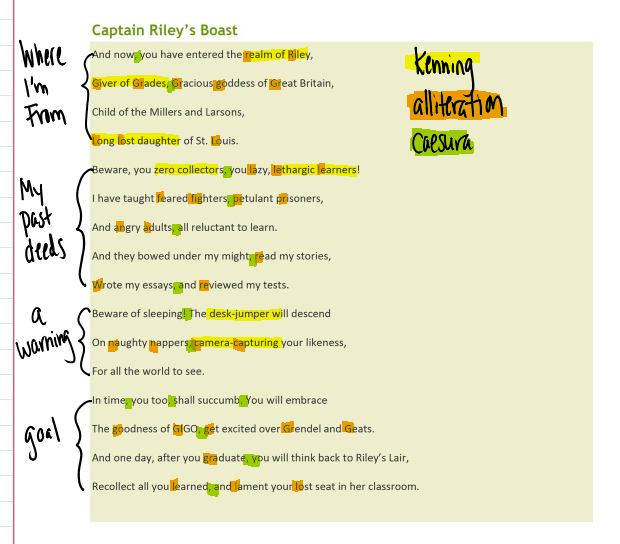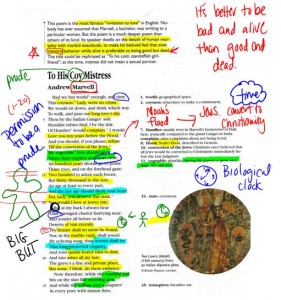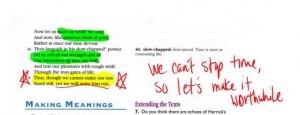Today, we just worked on our Obituary. Remember – every major grade is worth 150 points and I take 5 points off for each day late.
Today, we just worked on our Obituary. Remember – every major grade is worth 150 points and I take 5 points off for each day late.
Ahoy, mateys! Today, we started off class by filling out the What I’m Good At table. You can find this BB > Beowulf > Beo-Boast. Don’t worry about complete sentences – you can just list.
This is mine. You can write yours either in a Word document and turn that in, or you can just write your notes in the Comment section of the drop bop.
Then, we read The Coming of Beowulf. Remember, I gave you MY copy with notes so that you could attention and follow, not so you could zone out. We never read for all 80 minutes and we take lots of connection breaks, so when we are reading, I need you to be with me. It’s the Riley Show!
The instructions are in Beo-Boast, along with one of Beowulf’s boasts, a boast that someone wrote about Donald Trump, and a boast that I wrote about myself. I also put in boasts from two former students: Amber and Mayra. Amber has a great vocabulary and wrote using antiquated language. She went above and beyond what I asked. Mayra had a great, original opening and used good vocabulary, but this might be a little more accessible to you.
I also showed you guys how I organized MY poem, and then I gave you a simple outline of what you could do if you were struggling with your boast.

Here is what I drew on the board for you –
Another idea that you can use instead of a threat is a promise – a promise to your future or your enemies.
The one in black is MY structure and the one in brown is a suggested one (follow this form to boast about what you overcame at your home campus, all the changes that you’ve made here at Vistas, and then what goals you have (graduation and/or career goals). This will be due at the end of the week.
Today, we started out by talking about obituaries in general. They are the written notices of death that usually include a brief biography of the person. Then we read the poem The Dash by Linda Ellis and talked about that poem supports this quote from the Blog of Death:
Some people view obituaries as morbid stories, but in truth only one line of an obit deals with death. The rest of the story focuses on the amazing lives people lead.
We are going to write our OWN obituary in class. You need to focus on CARPE DIEM – how did you make your life extraordinary? You will need to be at least 75 years old (or older) – it’s hard to carpe diem a life when it’s short. Think about the Bucket List pre-writing and the Bucket List that we did this week – use those to find your focus. Is it family? Is it being successful? Is it helping other people? Use that focus to help you figure out details and events to your life.
Under Carpe Diem: Obituary, you can find instructions and examples, one of which being my own. Yes, I do every assignment that I ask you to do. The reason that I do this is so that I can share things that helped me when I did the assignment. The thing that helped ME the most when I wrote my obit was the Blog of Death. Seriously. I used it not for ideas, but for sentence structures and modeling. Use your Sentence Models that we did on Tuesday for help and inspiration!
For example, here is the first sentence of Demetius Newton’s obituary:
Rep. Demetrius C. Newton dedicated his life to improving the human condition, first as a civil rights attorney and later as a politician and public servant.
It’s a great sentence, but obviously, I’m not a civil rights attorney, politician, or a public servant. But it’s a great sentence.
So what I would do is this: I’d take out the specific information and leave blanks.
_____ dedicated her life to improving ____________, first as a ________ and later as a __________.
Now that it’s not specific, I can add in my own information.
Vanessa Riley dedicated her life to educating other, first as a teacher and later as the director of the at-risk high school that she founded.
If you look in BB, you can see the rubric that will be used to grade the obituary. You need to have a minimum of 500 words.
Then, we read Grandma Betty’s Obituary from the Blog of Death. What an amazing woman! Seriously, this is the legacy that I’d like to leave when I die! I love Grandma Betty!
Then, we looked at the Blog of Death in a little more detail. I skimmed through and showed you a few people that were of interest to me, and I showed you how to use the categories, even though I wish there was a place to actually see all of the categories!
The point of that was that we are searching for really good sentences that we can use as models or mentors when we start writing our major grade next week.
You have to find FIVE great opening lines. That is the opening line(s) of an obituary, not the paragraph. You have to find five great endings for an obit, and you’ll need to find five good general lines from anywhere in an obituary.
DO NOT JUST CHOOSE THE FIRST FIVE OBITS THAT YOU FIND AND CHOOSE THREE LINES FROM EACH. That is not the point of this, and it won’t help you write your paper next week. Seriously. This is NOT busy work, so if you get done in five minutes, that’s a sign to me that you just chose random sentences without thought.
If you want extra credit, if you find a really interesting Obit, put the person’s name in the last column so I can share it with other students. ![]()
I also have a list of the people that I find fascinating if you are getting stuck stuck looking people. As of right now, it’s not in Blackboard, so let me know if you need it. ![]()
Today was a pretty interesting day that showed a great amount of maturity in my students. I honestly was really impressed with the comments that people made.
First, we printed the lyrics to Marvin Gaye’s “Let’s Get in On”, listened to the song, and highlighted persuasive language in BLUE and highlighted references to TIME in yellow. Answer the three questions and drop off your highlighted lyrics (if you were absent so I can give you credit for highlighting along with the three questions).
We talked about the speaker and his audience (a girl) and analyzed that relationship. We highlighted evidence of carpe diem (time) in the poem, highlighted IRONY in the song, and highlighted references to LOVE in the song. We also specifically talked about how the song was contradictory and how it related to TIME (“stop beating ’round the bush”, and “this minute”).
We were really puzzled about the lyrics, especially the phrase “threatin’ you, baby”, so I did a little research. First, I wanted to make sure that I got the lyrics right, and it seems I did. So then, I went to Wikipedia and read this little tidbit. It seems Mr. Gaye had a troubled childhood and used his music to work through some of his issues. The power of poetry!
We talked about consent, and how the audience in the song has obviously NOT given consent.
Students then sat there puzzled as to why we listened to that song, so we read “To His Coy Mistress” to explain. It’s the original “Let’s Get It On”, just much creepier.
You can download my notes in a Word document so you don’t have to copy notes. Just save it wherever you save my stuff.

 I showed you eagles twirling and how that fit into the poem.
I showed you eagles twirling and how that fit into the poem.
Lastly, we did the Syllogism Pyramid foldable. You can find the template in LMS.
For each triangle, create a text box and write the following:
You will need to ROTATE the text box. Grab the little green ball and turn it. Make sure that the text box faces the hypotenuse. Don’t worry about the text that is already on the pyramid – that will be hidden when you fold it up.
We started out making a foldable – just making it. We will add little bits to it each day after we read. We’ve changed a few topics from the foldable to the left – just check with me and we can get you the right titles.
Today we started reading Beowulf. We will read just one section a day, so that means if you find the poem boring (I didn’t write it – it doesn’t hurt my feelings!), I won’t commit readicide on you by making you read for all 80 minutes of class. You can thank me later.
Today, we skimmed the background notes and read The Wrath of Grendel.
We spent some time talking about mead, the mead hall, and Bass Shandy soda.
If you weren’t here, you missed watching me jump on desk growling and you missed me harassing students with “Grendel”. Read this on your own and be familiar with it.
For first block, I explained the Metaphorical Response! A metaphor is a comparison between two UNLIKE things.
A metaphor is a comparison between two unlike things not using the word “like” or “as” to make the comparison. The greater the difference between the two things being compared, the better the metaphor. For example, if one were to say that “Football is baseball,” that would not be a good metaphor, because football and baseball are both sports. However, if one were to say that “football is chess,” that would generally be considered a better metaphor because there is a greater difference between football and chess than football and baseball.
That webpage has fifty good examples of metaphors, like this: The typical teenage boy’s room is a disaster area.
So, you’ll be finding a metaphor for the ten elements on the worksheet and explaining it. If you need help, check out the example in BB.
You only need to have ONE quote – not two or three like the example shows.
Just make sure that you use good metaphors.
For example (and don’t use this one), Grendel is nasty. No one likes him. No one wants him around, but no one can stop him.
Column 1: Grendel is like a SBD (silent but deadly fart).
Column 2: SBD farts are silent and sneak up on you. They are very powerful, and take down everyone within sniffing zone. The only way you can survive a SBD is if you run away! Not only are they silent, but you can’t see them.
Column 3: Grendel is very strong, and no one can defeat him. No one likes him, no one wants him around, but no one can figure out how to deal with him or get rid of him. Anyone who goes up against him, is destroyed. Just like a SBD, the only way you can survive an attack with Grendel is if you run away. Because Grendel hunts at night and the only survivors are those who flee, no one has ever seen Grendel, either!
Column 4: One quote that proves your comparison. Since we used a PDF file for Beowulf, you can’t copy and paste, so you’ll need to type it manually.
We ran out of time in second block because we talked about ticks so much, so I’ll go over that with you guys (and play the game!) tomorrow!
I was at teacher training today – BOO! I missed class. I made a review video for you guys to watch that was my Peanut Butter Jelly review. I *TOLD* you guys that I did every assignment as well!
Then, you took the quiz with your group. The goal of this is for you guys to TALK about what happened. If you missed, just take the quiz all by yourself – and realize that because you had group work, your teammates suffered because of YOUR absence!
Grades are updated in Gradespeed, so if you have any free time work on missing assignments.
I gave you time to finish the PP from yesterday. Then weread To the Virgins to Make Much of Time.
If you want, ask me why I find this poem so offensive.
We also talked about peaking in high school. If you peak in high school, then the rest of your life will be pretty depressing.

We went To The Virgins Discussion board to answer four questions. The What Age is best is mandatory, but the other three are YOUR CHOICE. Make sure you that you have four completed so you can get full credit. If you do MORE than four questions, you are earn extra points!
If you had to remain a certain age for the rest of your life, which age would you choose and why? When doing so, you may want to consider what you want out of life. Do you want independence? A family? A well-paying job? Children? Retirement? Leisure? Each age has advantages and disadvantages, but your task is to identify the best and explain why you think that way.
Why do you think Herrick chose “rosebuds” rather than, say, tulip buds? Does it have anything to do with the fact that a rose has a thorn? Why doesn’t the speaker say anything about the rose’s thorn?
What does the sun have to do with carpe diem (“seize the day”)?
Does this poem make you want to go out and seize the day? If so, what about the speaker’s argument do you find convincing?
Do you think that the speaker of this poem is young or old? What lines make you think so?
Do people get married for the same reasons as they used to during Herrick’s time (the 1600s)?
We finished doing Peanut Butter Jelly Time today! WE had a total of about 80 minutes to read and draw pictures.
Then, we did a Gallery Walk. That means in YOUR group, ONE person stayed with the poster to teach the students from the other groups and the rest of the group wandered over to the OTHER groups to hear. There are a few reasons we did the Gallery Walk, even though a few people found it repetitive.
We did a Word Storm of important vocabulary words that will be used for an activity tomorrow (and you can use on the final exam). If you weren’t here for this, get the words from a buddy or copy them down from here.